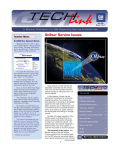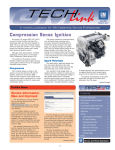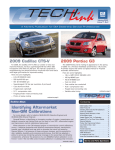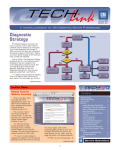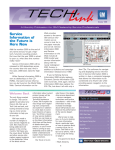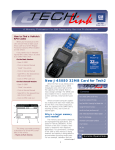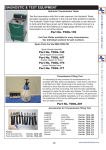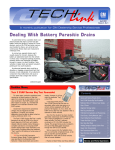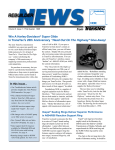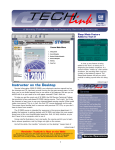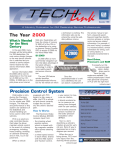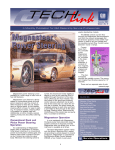Download It`s a New Tech 2 Look
Transcript
July 2000 Volume 2, No. 7 It’s a New Tech 2 Look In early July, your dealership will receive TIS data CD 13. Once your Techline terminal and Tech 2 are updated with this release, you’ll notice your Tech 2 has a new look – and some different functions – while using the Service Programming System (SPS) application. In an effort to develop more common programming for the Tech 2 between North America and International operations, GM Service Operations has taken the opportunity to update the Tech 2 functionality and logic as well. The result is a Tech 2 scan tool that provides users with more information while programming a vehicle along with more intuitive user interaction that makes the SPS application easier to use. And if you’re ever in Europe, you’ll be able to use it there too. The changes made to the Tech 2 include some differences in the navigation from screen to screen, but the fundamental steps and procedures are the same. When performing remote reprocontinued on page 2 Techline News Downloading SI 2000 Incremental Updates GM dealerships recently received the latest set of Service Information 2000 (SI 2000) CDs, version 2000.07. It includes service information on 35 new vehicle platforms. By updating the personal computers (PCs) in the service department that run SI 2000, the latest service information will be available in the dealership before many of those models hit the showroom floor. For GM dealerships in the U.S., new versions of the SI 2000 CDs will be released to GM dealerships about six times during the year. In between those CD releases, SI 2000 service information will be updated via satellite broadcasts to GM dealerships’ GM ACCESS servers every two weeks on a Friday night. Check every other Monday to see if your dealership has received new service information. By providing dealerships with updated information through satellite broadcasts, dealerships will receive timely information with fewer CDs to handle. Instructions for updating a PC with an SI 2000 incremental update are available under the SI 2000 Help menu. Under the Help menu, select "Checking your version number" to see the current version of SI 2000 running on the PC. From here, the current version is displayed, along with the release date of the next available incremental update and a link to the instructions for updating the PC for both Microsoft Internet Explorer and continued on page 3 1 Contents It’s a New Tech 2 Look . . . . . . . . . . . . . . . . . . .1 Downloading SI 2000 Incremental Updates . . . . .1 Cooling System Contamination . . . . . . . . . . . . . .4 Sentinel Dealers Offer Insight on Product Quality . .5 New Satellite Training Locations Open . . . . . . . . .6 A View from Inside the Warranty Parts Center . . .6 TAC Tips . . . . . . . . . . . . . . . . . . . . . . . . . . . . .7 Dinghy Towing Tips . . . . . . . . . . . . . . . . . . . . . .7 TechLink on the Web . . . . . . . . . . . . . . . . . . . .8 Bulletins . . . . . . . . . . . . . . . . . . . . . . . . . . . . .8 Service Operations perform service programming on these vehicles than with the direct programming method of hooking up the vehicle and Tech 2 directly to the Techline terminal using an RS-232 cable. There are new screens to build a vehicle. gramming, for example, it’s still the same three-step process that requires requesting information from the control module (or the electronic control unit, ECU, as it is now called on the Tech 2), uploading that data to TIS to see the available calibrations, and then returning to the vehicle to program the ECU. Other changes to the Tech 2 include more information on the screens that help guide the user through the procedures. One of the goals when developing the new Tech 2 screens was to help technicians understand what is happening at each stage of a procedure. The screens now offer better explanations of the user options and what can be done next – all to help avoid mistakes. After information has GM TechLink is a monthly magazine for all GM retail technicians and service consultants providing timely information to help increase knowledge about GM products and improve the performance of the service department. This magazine is a companion to the GM Edge publication. VSSM Communications Gracemary Allen Publisher & Editor: Mark Stesney GM Service Operations [email protected] Technical Editors: Mark Spencer [email protected] 1-248-816-3647 Jim Horner [email protected] 1-248-816-3641 More Information and Support Production Manager: Marie Meredith One of the biggest changes is that with the updated software, the Tech 2 will now support Keyword Protocol 2000. This means you can use remote programming when working on The new screens offer more information. a Cadillac Catera or Chevy been requested from an ECU, for examTracker. Keyword Protocol is a type of ple, the Tech 2 will display the message, communications protocol used by those "Request info. is complete. Tech 2 is models, just as most North American ready to connect to PC." GM models use Class 2 communication or older models use UART. As you can Since many of the screens are new, imagine, this will make it a lot easier to it’s important to take the time to read each screen so that you’re sure you know exactly what the next button push will do. "Building" a Vehicle Previously, when Service Programming was selected from the main screen, it was necessary to build the vehicle – in essence, tell the Tech 2 the vehicle you’re working on – before requesting any information from the vehicle. After successfully request- Desktop Publishing: Greg Szpaichler, MediaWurks [email protected] FAX number: 1-248-649-5465 Write to: TechLink PO Box 500 Troy, MI 48007-0500 General Motors service tips are intended for use by professional technicians, not a "do-it-yourselfer." They are written to inform those technicians of conditions that may occur on some vehicles, or to provide information that could assist in the proper service of a vehicle. Properly trained technicians have the equipment, tools, safety instructions and know-how to do a job properly and safely. If a condition is described, do not assume that the bulletin applies to your vehicle or that your vehicle will have that condition. See a General Motors dealer servicing your brand of General Motors vehicle for information on whether your vehicle may benefit from the information. Inclusion in this publication is not necessarily an endorsement of the individual or the company. Copyright© 2000 General Motors Corporation All rights reserved. The Tech2 now provides simple direction. 2 Return to page 1 ing vehicle information and uploading that information to the TIS terminal, it was necessary to build the vehicle again before programming. Now, with the new changes that have been made, the Tech 2 will only ask you to build a vehicle when it needs to know that information. Specifically, that’s when you’re about to request information from an ECU. The user is presented with a screen that lists vehicle makes, and then up to five additional screens identifying vehicle data such as model year and vehicle type. Once a vehicle has been built in the Tech 2, that data is now stored until reprogramming has taken place or information is requested again from an ECU, in which case the vehicle will need to be built again. keys available. Before reprogramming an ECU, double check to make sure you’re reprogramming the same ECU from which information was requested. New Soft Keys and Selections When reprogramming the Vehicle Theft Deterrent (VTD) system, for example, there are just two selections available: Request info. and Program. Previously, there were soft keys for VTD, PIN display and content theft information. By simplifying the number of keys, and in turn, the number of choices, it’s easier to use the tool. Now, simply request information from the ECU in the system you’re working on or program the ECU. In several procedures, you’ll notice that the new screens on the Tech 2 have different soft keys than in the past. Or there may not be any soft keys available at all. In these cases, there are new selections or function To use all the latest Tech 2 screens and their added functionality, remember to update your Tech 2 with TIS data CD 13. – Greg Powell contributed to this article. And remember, when replacing an ECU it’s necessary to request the security code from the new ECU, not the one being replaced. continued from page 1 Downloading SI 2000 Incremental Updates 2000.07.02 for the current version will be stored on the GM ACCESS server until an incremental update of the next version release, 2000.08, has been broadcast. Incremental update 2000.08.01 will erase any previously released updates. Updating the PCs in the service department with the SI 2000 incremental update may take up to one hour, depending on the activity on the dealership’s GM ACCESS server as well as the performance and speed of the PCs. Since a PC cannot be used while being updated, and high amounts of activity on the server slow the updating process, it’s recommended to Instructions for updating SI 2000 is available for both Internet Explorer and Navigator users. Netscape Navigator users. If the incremental update has not been released yet and is not available on the dealership’s GM ACCESS server, a "page not found error" will be displayed when the link is selected. When updating SI 2000 on a PC, each SI 2000 incremental update must be downloaded in order. They cannot be executed on the PC out of the order of their release. This is because each update includes only new perform the SI 2000 incremental updates when there is a low demand on the dealership’s computer network. As the incremental updates to the CD versions of SI 2000 are broadcast to U.S. dealerships, the SI 2000 Web site also is updated at the same time. Currently, to access SI 2000 on the Web, log on to service.gm.com and enter your password and ID. If your dealership does not have a password and ID for the SI 2000 Web site, contact your dealership’s Regional representatives for the necessary access information. – Lisa Scott, Mike Waszczenko information and is not a cumulative collection of previously released information. All the information from each incremental update is compiled on the next release of CDs. As the incremental updates are broadcast to the dealership every two weeks, they are stored on the GM ACCESS server. They will stay on the server until the next version of SI 2000 CDs is released. For example, updates 2000.07.01 and The expected broadcast date of the next update can be found under the Help menu. 3 Return to page 1 Cooling System Conditions on Vehicles Equipped with DEX-COOL™ General Motors made DEX-COOL™ Extended Life Coolant standard equipment in all North American-built vehicles (except Saturn) beginning in the 1996 model year. Some assembly plants made the conversion over the 1995 Memorial Day shutdown, and all remaining plants were converted for the 1996 model startup. For the post-Memorial Day built 1995 models filled with DEX-COOL™ and all 1996 models, the coolant maintenance/change interval is 5 years or 100,000 miles, whichever occurs first. In 1997, that interval was increased to 5 years or 150,000 miles, whichever occurs first, which is where it remains today. Several important factors contributed to the decision for GM to be a pioneer in the conversion to extended life coolant. The convenience and financial benefit to the customer of not having to change coolants as often is obvious. Additionally, the result of having less used coolant to dispose of has the potential to result in significant benefits to the environment. GM also has realized significant increases in water pump durability, and radiator and heater core life. DEX-COOL™ is a non-silicated coolant, while most conventional green coolants contain silicates. One undesirable property of silicates is that they are abrasive and over time can contribute to wear of water pump seals, as well as other components. Overall, DEX-COOL™ Extended Life Coolant has performed very well in GM vehicles. However, for a combination of reasons, a few models experience varying degrees of contamination to the radiator cap and/or coolant recovery bottle. In some cases, if the contamination is left unchecked, it can cause problems in other areas of the engine cooling system. We’ll try to assist you in determining the specific type of contamination present, and discuss the most appropriate correction. We’re limiting our discussion to cooling systems that use a drop-center design radiator cap, and a non-pressurized coolant recovery bottle. The Radiator Cap When a cooling system is not full, the air pocket that is created in the radiator provides a "beachhead" where contaminants can deposit. This occurs much like sand is deposited by waves on the beach. In cooling systems that use a drop-center cap and non-pressurized coolant recovery bottle, these contaminants can deposit in the valve mechanism of the radiator cap. Once the cap becomes contaminated and ceases to function as designed, chances are that the system will begin to lose additional coolant more rapidly. This is because once the radiator cap fails to hold pressure, a 50/50 mix of coolant and water will boil at 226 degrees Fahrenheit, instead of 265 degrees Fahrenheit, at 15 PSI. By boiling at a lower temperature, it is much easier to exhaust the capacity of the coolant recovery bottle as the coolant expands through the failed cap at the lower temperature. When the system cools off, less coolant will then be available to be drawn back into the radiator. After several cycles under these conditions, the level of coolant in the radiator can be significantly reduced and the coolant recovery bottle will be empty. It is for this reason that the condition and functional ability of the radiator cap is so important. Always test the functional performance of any radiator cap whenever cooling system performance is in question, and replace any cap that does not hold the specified pressure. When removing a radiator cap, be sure to wipe off all sealing surfaces prior to replacement, in order to ensure a proper seal. There are only a few models where the system design appears sensitive to this type of contamination. Although the contaminant may be similar looking, different models usually have different recommended repairs. That’s because the makeup of the contaminant is often characteristic to a model or engine family. Because of this, each model should be carefully evaluated to assure the appropriate repair is being made. The most effective method of preventing, minimizing or eliminating the affects of contaminants is to always maintain the cooling system (including the recovery bottle) at its recommended full level and ensure the radiator cap is functioning properly. S/T Truck Equipped with 4.3L V6 Bulletin 99-06-02-012B outlines the most effective repair for this model. The contaminant has been identified as iron oxide, and the cleaning material recommended in the bulletin was selected because it was proven to be the most effective at cleaning this type of contaminant. It is very important to follow the steps outlined in the bulletin precisely. Cases where the procedure was not effective have almost always been traced to substitution of another cleaning material or the procedure was not strictly adhered to. The most common mistakes have been: cleaning will not be effective. 2. Failing to correctly assess the level of contaminants in the radiator before beginning. NOTE: As stated in the bulletin, it’s important to determine if coolant is able to flow through the third row down from the top of the radiator. If not, the radiator core must be replaced before the flush procedure. This is because the cleaner must be able to flow past the contamination in order to clean it. In cases where the system can’t achieve sufficient flow around the contaminants, the cleaner cannot be effective. W Car / U Van Equipped with 3.1L or 3.4L V6 Bulletin 00-06-02-004 describes the appropriate repair procedure for the issues most often seen on these models. Although similar in appearance to the S/T issue, the material on the radiator caps of these models contains no iron oxide. It is much more gelatin-like in texture and is usually comprised of sealer pellet residue, hose material and/or other contaminants. It is very rare to see cases where the contamination evidenced on these radiator caps has spread beyond 1. Running the flush while the engine operating temperature is too low. Heat acts as a catalyst in this procedure, and if the temperature of the system is not maintained according to the bulletin specifications, the 4 Return to page 1 Sentinel Dealers Offer Insight on Product Quality the radiator neck. If contamination is suspected beyond the radiator neck, you may choose to remove the radiator end tanks for further inspection. Replacement of the radiator cap, wiping out the radiator neck and topping off the system is all that is normally recommended for these models. Unless other symptoms are present, it is not necessary to flush the cooling system or replace the coolant on these models before their published maintenance/change interval. GM is constantly looking for ways to improve the quality of its cars and trucks, and with the help of many dealerships, is doing just that, along with improving customer satisfaction. The Sentinel Dealer Program is a voluntary program for GM dealerships where they contribute valuable insight about product quality issues and provide details about customer product concerns. Approximately 150 dealerships in the U.S. are currently participating in the Sentinel Dealer Program. As the program grows, it will be rolled out to dealerships in Canada and Mexico. 2000 LeSabre and Bonneville Equipped with 3.8L V6 Concerns on these models typically center around what is perceived as discolored coolant (usually dark and rust colored in appearance) and a ring of contamination around the inside of the coolant recovery bottle. Analysis has determined that both of these consist of excess sealer pellet material that was inadvertently installed at the assembly plant. Sealer pellet installation has since been discontinued on these models. Cleaning the coolant recovery bottle, topping up the system and checking the cap for proper function is all that is required on these models. Dealerships are selected to participate in the Sentinel Dealer Program based on several factors, including geographic location, sales volume and product mix, and willingness to help resolve product issues. Currently, participating dealerships also must have an ADP or Reynolds & Reynolds computer system with an electronic repair order process. Finally, as stated in bulletin 99-06-02-012B, the radiator cap is not a good indicator of the general condition of the cooling system. Typically the underside of the radiator cap will exhibit a greater amount of contamination than the rest of the system, due to the "beach" effect described earlier. Likewise, the color of the coolant is also not a good indicator of its general condition. Due to fading of the dyes used with DEX-COOL™, the coolant in some vehicles may appear pink after time. The addition of sealer pellet (stop leak) material can turn the coolant color to dark red or maroon. As a rule, color alone is not an indication of the quality level of the coolant and does not affect its performance. The condition, cause and correction information from the repair orders generated by Sentinel Dealers is sent to GM through the WINS warranty system. The WINS system captures the first 60 characters of the condition line, the first 80 characters of the cause line, and the first 60 characters of the correction line and submits that information to be put into a GM quality database. Because of the limited amount of information that can be captured, it’s important for participating dealers to be concise when summarizing condition, cause and cor rection information on the repair order. All of this quality-related data is made available to more than 8,000 GM engineers at all levels of the design, manufacturing and assembly processes. One of the latest product issues GM is working on is paint quality. GM North America Paint Engineering is asking Sentinel dealers, as well as all other dealers, to identify and provide feedback on warranty paint repairs. All dealers who would like to participate are asked to use a digital camera to take a digital picture (jpg) of the area on a vehicle that needs warranty paint repair and e-mail the file to North America Paint Engineering. The file name of the picture should be the last six digits of the VIN and e-mailed to [email protected] along with the full VIN and a contact name and phone number at the dealership. When performing repairs for S/T trucks, U vans and W cars, it may help to replace the standard radiator cap with a Standt model 10230 or 11230 radiator cap. These caps have a spring center design that may be less sensitive to the effects of low coolant contamination. You should also top off the radiator and fill the coolant recovery bottle to the hot mark when cold. These measures will combine to guard against the vehicle operating with the cooling system low on coolant. Inform the customer to check the level of the coolant recovery bottle regulary and to maintain it at the proper level by adding a 50/50 mix of DEX-COOL and water whenever it’s found to be low. DEX-COOL™ continues to perform extremely well in the majority of GM vehicles, and has provided a competitive performance and environmental advantage. Other manufacturers are recognizing these benefits. At present, in addition to all North American-built GM vehicles, Texaco extended-life coolant (DEX-COOL™) technology is either in use or approved for use by several other European and North American manufacturers. After reviewing the photo and the corresponding warranty claim data, the information will be sent to the quality manager at the responsible production plant. The dealership will be supplied with feedback about their paint issue, and what paint quality improvements GM is going to take. The paint quality program is set to run until September 1, 2000. For those vehicles that may potentially be affected by contamination, the most effective method of eliminating any risk of the contaminants is to maintain the cooling system (including recovery bottle) at its full-recommended level, and ensure the radiator cap is functioning properly. Dealers who would like to participate in the Sentinel Dealer Program to help GM improve product quality should contact Jack Pantaleo, Sentinel Dealer Program manager, at 1-248-874-3659. – Jay Dankovich – Jack Pantaleo 5 Return to page 1 New Satellite Training Locations Open Hands-on technician training may be coming closer to your dealership. In addition to the six regional GM Training Centers, there will be 17 new GM satellite training locations opening soon at colleges and other locations around the country. These new satellite locations will offer hands-on training just as the regional training centers. The satellite locations, however, will not be conducting body or endorsement courses. Several satel lite locations began holding training classes last month and more will open in the coming months. The satellite locations were determined based on dealership density, the number of technicians in the area and commuting distances. Any questions relating to the satellite training locations can be directed to the associated Regional Training Center or the GM STC Help Desk at 1-800-336-0886. Hands-on course information as it relates to date(s) and location(s) offerings can be found in the schedule and enrollment areas of the Training Management System (TMS) and in the monthly GM Common Training Program Guide and Schedule. SOUTHEAST REGION Atlanta Training Center, Alpharetta, GA (770) 888-1300 Satellite locations: Seminole Community College, Sanford, FL Central Piedmont Community College, Charlotte, NC NORTHEAST REGION New York Training Center, Tarrytown, NY (914) 631-4950 Satellite locations: Allegheny Community College, Pittsburgh, PA A View from Inside the Warranty Parts Center Hudson Valley Community College, Troy, NY Harrisburg Community College, Harrisburg, PA SOUTH CENTRAL REGION The community of Orion, Michigan, located about 25 miles north of Detroit, is the home of the GM Warranty Parts Center (WPC). Regardless of where your dealership is located, if you’re asked to return a part that was replaced under warranty, this is where it ends up. You probably have questions about the warranty parts return process, so TechLink recently visited the WPC to obtain some answers. Dallas Training Center, Garland, TX (972) 278-2196 How can I learn about the Corporate Parts Return (CPR) Program? Satellite locations: Refer to bulletin 99-00-89-019, effective October 1, 1999. It pertains to all 2000 and prior passenger cars and trucks and provides instruction about parts retention, preparing parts for shipping, and administration. Longview Community College, Lees Summit, MO How do I know which parts to return? San Jacinto Community College, Pasadena, TX Dealers are notified which parts to return through the Dealer Communication System twice per week. Once a part is requested, the dealer has 28 days to return the part. A debit is processed if the part is not received within the time limit. Delgado Community College, New Orleans LA The return request will list specific warranty claims for which parts are to be returned. You should return only the parts asked for, but do not include parts not requested. Ship each individual request in a separate box; do not batch multiple requests in a single box. Ranken Community College, St. Louis, MO Training Solutions (Snap-on), Memphis, TN How should parts be returned? NORTH CENTRAL REGION Chicago Training Center, Hinsdale, IL (630) 323-6000 Satellite locations: WPC has established a contract with UPS to handle returns. Where possible, use the container from the replacement part. Drain fluids and wipe the part clean. Include properly protected paperwork, according the the bulletin. Why does GM ask for parts to be returned to the WPC? Dakota County Tech, Rosemount, MN Analyzing returned parts will assist in improving product quality, reducing customer dissatisfaction and reducing warranty expense. Sinclair Community College, Dayton, OH What happens to a part when it’s received by the WPC? Detroit Training Center, Warren, MI (810) 576-3308 WESTERN REGION Los Angeles Training Center, Burbank, CA (818) 558-1620 When parts arrive at the WPC, they are either inspected on-site or shipped to a supplier for review. Parts inspected at the WPC go through a structured review process. A typical review meeting may include GM release engineers, supplier quality representatives, the supplier, service information writers, and Brand Quality and TAC managers. They conduct analysis, brainstorming and problem solving of issues. The root cause analysis of each part is entered into the WPC database. The result of the meeting is a report of the cause, complaint and corrective action. From this, the group develops a plan for design changes, manufacturing process improvements and service manual/diagnostic changes. Satellite locations: Portland Community College, Portland, OR What if I have questions regarding receipt of a part? Los Positas, Livermore, CA Glendale Community College, Glendale, AZ Weber State, Ogden, UT Training Solutions (Snap-on), Wheat Ridge, CO The WPC Website has implemented a Dealer query on its website. Dealers can query for an Open Status report that lists open requests and their due dates or query individual part requests. The Dealer’s Business Associate Code (BAC) and a Request Number is necessary for an individual request. The website is <<www.gmwpc.com>>. The website will also provide information regarding a debit. Upon inserting a Request Number, the dealer will receive an explanation of why a request was debited. - Gary McAdam and Annie Chi contributed to this article. – Jean Hart 6 Return to page 1 TAC Tips 2000 Cadillac Escalade Rosen Entertainment System A special phone number has been established for assistance with diagnosis of the Rosen entertainment system on 2000 Cadillac Escalade models. To contact Rosen Technical Assistance, call 1-800-284-7677 from 8:00 am - 5:00 pm, Pacific time. 1999-00 Tracker Automatic Light Control Cannot Be Disabled The Automatic Light Control (ALC) system on 1999-2000 Chevy Tracker two- and four-wheel-drive models will turn the headlamps, taillamps, and instrument panel lamps on when the dash sensor (ambient light sensor) is shadowed for 3-5 seconds or at Dinghy Towing Some Important Tips Earlier this Spring you received Bulletin 00-00-89-008, which contains the latest word on dinghy towing. Dinghy towing refers to towing a vehicle with all four wheels on the ground, for instance behind a motor home. Your customers may have questions about which vehicles can be towed this way, and how to do it correctly. Refer them to the Owner’s Manual for guidance. Details are also included in the bulletin mentioned above. Be sure to read the bulletin completely and follow the procedures exactly, to avoid damage to the vehicle being towed. These are the highlights. dusk. The ALC system cannot be disabled by setting the parking brake prior to ignition. With the engine running and the headlamps off, lifting the parking brake handle to the first click will turn off the daytime running lamps (DRL) and turn on the instrument panel brake indicator light. The DRL's will remain off and the instrument panel brake indicator light will remain on until the parking brake is released fully. 2000 4.6L Engines Low Oil Message Remains On Some 2000 model year Cadillac DeVille, Seville and Eldorado models equipped with the 4.6L (LD8, L37) V8 engines may exhibit a condition where the low oil message remains on after an oil change or a previous low oil condition. If there is loose paper in the glove box of a 2001 Oldsmobile Aurora, it’s possible for the paper to be pulled into the HVAC system when the system goes into the recirculation mode. This may result in noise coming from the HVAC system as well as blower motor imbalance. Advise owners to remove loose papers from the glove box. Additional information about any repair procedures will be provided when available. – GM Technical Assistance NOTE: Refer to the service manual for propeller shaft removal and installation. Provisions must be made to keep the lubricant in the transmission and dirt out. - Shift the transmission to Neutral. Then release the parking brake. - Place the automatic transmission in PARK, or the manual transmission in first gear. - Do not exceed 65 mph while dinghytowing. Light Duty Trucks with 4-Wheel or All-Wheel Drive Certain T and K trucks may be dinghytowed with the transfer case shifted to Neutral. These are listed in the Bulletin. NOTE: Cars must not be towed backward or the transmission may be damaged. If dinghy-towing, follow this procedure. - Set the parking brake. - After hooking the vehicle to the towing vehicle, shift the transfer case to Neutral. Be aware that the vehicle can roll, even if the transmission is in Park or in gear. - Release the parking brake. - The steering column must be unlocked. The Owner’s Manual specifies the appropriate ignition key position to ensure that the steering is unlocked to allow the front wheels to follow the tow vehicle. Light Duty Trucks with Rear Wheel Drive The bulletin spells out exactly which vehicles may be towed. Generally, they are those with front wheel drive and either the 4T40-E or 4T45-E automatic transaxle or the MK7 or MJ1 5-speed manual transaxle. - First, set the parking brake. - After hooking the vehicle to the towing Noise From the Aurora HVAC System vehicle, the steering column must be unlocked. The Owner’s Manual specifies the appropriate ignition key position to ensure that the steering is unlocked to allow the front wheels to follow the tow vehicle, and to ensure that the transmission shifter is unlocked, without starting the engine. Passenger Cars - Because the ignition key must be turned from the LOCK position, it’s necessary to pull the fuse(s) indicated in the Owner’s Manual. This prevents the instrument panel or electronic PRNDL from draining the battery. If all published diagnosis has been performed and the condition still exists, it may be caused by a PCM software calibration. An updated PCM calibration was released on Techline 2000 data CD #4 (released to the field on March 2, 2000) to correct for the low oil message condition. The remaining T and K trucks with 4wheel- or all-wheel-drive can be dinghytowed only with the propeller shafts removed. For these trucks, the preferred towing method requires use of a platform trailer which lifts all four wheels from the pavement. 7 These vehicles should not be dinghy-towed. The preferred towing method requires use of a platform trailer which lifts all four wheels from the pavement. If towing on all four wheels is unavoidable, the propeller shaft must be removed and the steering column unlocked. NOTE: Refer to the service manual for propeller shaft removal and installation. Provisions must be made to keep the lubricant in the transmission and dirt out. Return to page 1 Bulletins – June 2000 This review of service bulletins released through mid-June lists the bulletin number, superseded bulletin number (if applicable) subject and models. GENERAL INFORMATION: 00-00-89-011; April, 2000 Bulletin Summary; 2001 and Prior Passenger Cars and Trucks 00-00-89-012; June, 2000 Labor Time Guide Updates; 1996-2001 Passenger Cars and Trucks HVAC: 00-01-38-005; A/C Condenser Instability, A/C System Inoperative (Inspect A/C System and Install Washers or Replace Condenser); 1997-2000 Chevrolet and GMC F Model TSeries Tilt Cab Medium Duty Trucks With Air Conditioning (RPO C60) STEERING: 00-02-35-004; Steering or Front End Road Induced Vibration (Install and Reinforce Revised Steering and Suspension Components); 1999-2000 Chevrolet and GMC C1500 Pickup Trucks (Silverado and Sierra) Built Prior to VIN Breakpoints BRAKES: 00-05-22-004; Brake Fluid Level and Filling Recommendations; 2001 and Prior Passenger Cars and Trucks 00-05-23-003; Front Disc Brake Squeal (Install New Front Disc Brake Pads); 2000 Chevrolet and GMC G30 Vans, Built Prior to May 2, 2000 ENGINE/PROPULSION SYSTEM: 99-06-04-057A; Replaces 99-06-04-057; Body Control Module (BCM) Related Service, Theft Deterrent Re-Learn Procedure; 2000 Chevrolet Impala, Monte Carlo TechLink on the Web In response to reader comments, we announced in May that we’re considering a permanent TechLink Web site. Before that can happen, we need your input. You can do that in one of two ways. First, there is this simple, 5question survey. You can fill it out and fax it to 1-248-649-5465. Or, better yet, take a look at the sample Web site at www.gmtechlink.com and fill out the survey while you’re there. The Web site will only be up and running for a short time. And we’ll be tabulating the results by the end of July, so please get your survey sent in by then. Thanks for taking the time to let us know what you think. 00-06-01-003; Release of New Exhaust Manifold/Turbocharger Heat Shield; 1998-2000 Chevrolet and GMC C6-7 Series Conventional Medium Duty Trucks With 3126 CAT® 275 and 300 hp Diesel Engine 00-06-01-012; Replaces 87-61-24; Use of "Surface Conditioning Discs;" 2000 and Prior Passenger Cars and Trucks 00-06-02-004; Brown Colored Gel-Like Substance on Radiator Cap and Upper Filler Neck (Replace Radiator Cap and Clean Radiator Upper Filler Neck); 1997-2000 Buick Century, 1996 Chevrolet Lumina APV, 19962000 Chevrolet Lumina, Monte Carlo, 19972000 Chevrolet Venture, 2000 Chevrolet Impala, 1996-97 Oldsmobile Cutlass Supreme, 1996-2000 Oldsmobile Silhouette, 1996-97 Pontiac Trans Sport, 1996-2000 Pontiac Grand Prix, 1998-2000 Pontiac Montana, With 3.1L or 3.4L Engine (VINs J, M, E, X - RPOs LG8, L82, LA1, LQ1) 00-06-03-003; Supplements but does not replace 99-06-03-012; Battery Testing and Replacement; 1997-2001 Passenger Cars and Trucks (Except 2001 Chevrolet Corvette) 00-06-04-007A; Replaces 00-06-04-007; Increased Accelerator Pedal Effort (Replace Throttle Body); 1999-2000 Chevrolet and GMC C/K Pickup Models (Silverado and Sierra), with 4.8L, 5.3L or 6.0L V8 Engine (VINs V, T, U - RPOs LR4, LM7, LQ4) 00-06-04-021; Proper Service of Quick Connect EVAP System Connectors; 19852001 Passenger Cars and Trucks 00-06-05-002; Exhaust Boom at 1500 RPM (Install Spacers to Exhaust Hanger); 2000 Chevrolet Corvette Built from SOP through December, 1999 TRANSMISSION/TRANSAXLE: 00-07-30-006; Replaces 87-71-63; Stalls/Surges at Stop or When Shifted to Drive or Reverse (Install Updated Calibration); 1998-2000 Chevrolet and GMC C/K Models and G Vans, With Hydra-Matic Fill out this questionnaire online at www.gmtechlink.com or copy this page and fax it to 1-248649-5465. 1. What is your job? ❑ A. Technician 4L80E Transmission (RPO MT1) 00-07-30-007; Whine Noise in Park or Neutral, Service Engine Soon or Service Vehicle Soon Lamp Illuminates (Replace Drive Sprocket Support Bearing); 1999-2000 Buick LeSabre, Park Avenue/Ultra, Regal, Riviera, 1999-2000 Chevrolet Lumina, Monte Carlo, Venture, 1999 Oldsmobile Eighty Eight, 1999-2000 Oldsmobile Intrigue, Silhouette, 1999-2000 Pontiac Bonneville, Grand Prix, Montana, With 3.4L or 3.8L Engine (VINs E, H, K, 1 - RPOs LA1, LX5, L36, L67) and Hydra-Matic 4T65-E Transaxle/Transmission (RPOs MN3, MN7, M15) 00-07-30-009; Current Model Year Goodwrench Transmission Replacement Assembly; 1998-2000 Passenger Cars and Light Duty Trucks with 4L30E, 4L60E, 4L80E, 3T40, 4T40E, 4T45E, 4T60E, 4T65E or 4T80E Automatic Transmission 00-07-30-011; Replaces 72-05-02; ACDelco® Remanufactured Transmissions; 1996 and Prior Passenger Cars and Trucks BODY AND ACCESSORIES: 99-08-42-007A; Replaces 99-08-42-007; Daytime Running Lamps (DRL) Disable Procedure; 2000 Chevrolet and GMC C/K Pickup (Silverado and Sierra), M/L, S/T Models, 2000 Oldsmobile Bravda, Built After VIN Breakpoints 00-08-49-003; Rattle/Squeak in Right Side of Instrument Panel or Right Front Door Trim Panel Scratched or Right Side End of Instrument Panel Contacting Door Trim Panel (Remove Instrument Panel Assembly and Align Tie Bar); 1995-2000 Chevrolet Cavalier and Pontiac Sunfire 00-08-63-003; Noise at Torsion Bar Location, Cab Difficult to Open, Torsion Bar Broken (Inspect/Replace Cab Pivot Torsion Bar); 1997-98 Chevrolet and GMC F Model TSeries Medium Duty Tilt Cab Trucks 00-08-110-002; Removing Adhesive Residue from Interior Door Trim Panels; 2000 Chevrolet Impala, Monte Carlo 3. Would you like to see GM TechLink available on the Internet? ❑ A. Yes ❑ B. No ❑ C. Service Manager 4. If GM TechLink were available on the Internet, where would you most likely access it from? ❑ D. Other ❑ A. Dealership ❑ B. Service Consultant 2. Which of the following best describes your business? ❑ A. Retail Dealership ❑ B. Fleet ❑ C. Other Service Facility ❑ D. GM Wholesale Organization 8 ❑ B. Home ❑ C. Both 5. Would you like to see GM TechLink expanded to cover mor e service issues? ❑ A. Yes ❑ B. No Return to page 1








